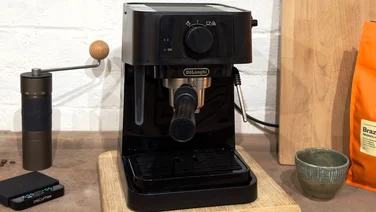To help us provide you with free impartial advice, we may earn a commission if you buy through links on our site. Learn more

- Makes consistently great espresso
- Fast warm-up time
- Almost instant hot water and steam
- Water tank is a bit plasticky
- Grind timer doesn’t offer fine control
Making great coffee all comes down to one thing: consistency. You might not have realised it, but weight, temperature, time and pressure all need to combine with near-mathematical precision to produce the perfect espresso. Needless to say, if you want to get the best from your coffee beans – and do so reliably time after time – then it pays to be precise. Sage’s latest coffee machine, the Barista Pro, is designed to be exactly the tool you need.
Sage Barista Pro review: What you need to know
The Barista Pro will be familiar to anyone who has seen one of Sage’s recent mid– or high-end machines. On top, a built-in burr grinder is fed with a bean hopper that holds up to 250g of beans and there’s a wide, ribbed space for cups and paraphernalia alongside it. Underneath, a capacious metal drip tray spans the width of the machine to catch grounds, water and drips of coffee.None of this is a departure from the norm but, under the surface, Sage has rung the changes. The Barista Pro swaps the classic boiler design of its other mid-range and top-flight stablemates for Sage’s “ThermoJet” technology. This has one key appeal: speed. It means the machine gets to the correct temperature in less than three seconds, and doesn’t need to be vented to cool down after heating up to deliver steam. The result? It’s ready in the slow blink of an eye.
Another key feature is that this is a volumetric machine. This means that it accurately measures how much water it’s pushing through each time and does so consistently. Cheaper machines simply run the pump for a set amount of time, so how much water actually makes it through the coffee grounds and into your cup depends entirely on how finely you grind the coffee and how hard you tamp it down. Suffice to say, if you want a consistent espresso, both in terms of flavour and amount, a volumetric machine is a giant leap forward from lesser machines.

Sage Barista Pro review: Features and design
We’d expect nothing less for the money, but the Barista Pro looks and, in the main, feels like a high quality machine. There’s no touchscreen or fancy display here and the simple LCD screen on our model is surrounded by an expanse of matte black metal. If you’re not partial to the all-black kitchen vibe then fear not; it’s also available in the more familiar stainless steel finish. Whichever you choose, the smooth curves and understated looks will be right at home in any kitchen and at 417mm tall, it should slip neatly under most over-counter cupboards.
It’s nice to find that almost everything you need to get started is in the box. There’s a decent-sized stainless steel milk jug, a coffee tamper (albeit a basic plastic one), and Sage’s Razor tool, which is designed to help get the perfect amount of coffee in the portafilter every time – or at least as close as possible without reaching for a (decent) set of digital kitchen scales.
The 54mm portafilter feels far heftier than the cheaper one bundled with the £399 Bambino Plus. It has twin spouts on its underside, and locks into place with a firm, solid twist.

Sage also includes both single-wall (unpressurised) and dual-wall (pressurised) baskets for the portafilter, and in both single and double-shot sizes. The pressurised baskets will come in very handy for beginners as they make it a little easier to get good results if you can’t be bothered to seek the perfect grind and tamp. And, if you have to resort to supermarket-bought ground coffee rather than good quality fresh beans, then they also help to eke as much crema as possible from coffee that’s past its fresh best.
My only complaint? The water tank’s handle is too plasticky for my liking. When filled to its two-litre capacity, it doesn’t feel hugely substantial. I routinely ended up cradling it with two hands just to be on the safe side.
Sage Barista Pro review: Ease of use
Even if you’ve never used a manual espresso machine before, then it’s worth pointing out that the Barista Pro’s manual will have you up and running in no time. It explains the whole process in a clear and uncomplicated manner and lets you know what to look out for – both in visual and taste terms. It’s great to see a manufacturer providing a manual that’s genuinely instructional.
The process begins with the grind. Press the portafilter into the jaws of the grinder and a click mechanism sets the grinder in action. The screen above provides a countdown timer: you can spin the dial a click in either direction to lengthen or shorten the grind time in 0.5 second chunks or you can just click the portafilter inwards to manually stop or restart the grind.

The only annoyance is that I often found myself needing to manually add a little extra to get a perfect 18g dose and particularly so as the coffee beans I was using aged over a few days. Personally, I’d prefer a little more granularity to get the perfect amount of coffee to fill the portafilter – in my opinion, the 0.1 second gradations on Sage’s the Smart Grinder Pro (£179) are a more sensible choice for getting the dose just so.
It isn’t just the grind time that’s adjustable, however. The Barista Pro also allows you to choose how long to infuse the coffee before extraction (this forces water into the ground coffee for a set amount of time to help eke out the most flavour), and you can customise exactly how much hot water you want to push through the coffee for the single-shot and double-shot buttons.
An on-screen timer starts ticking the moment you press the shot button, and allows you to more accurately judge how long it’s taking to pull the shot. This is key, as the differences in flavour between a 20-second and a 35-second extraction aren’t small. It pays to optimise the infusion and extraction times to suit the types of coffee beans you’re using, and also how long ago they were roasted.
A dial on the machine’s right-hand edge controls the hot water and steam delivery; you simply twist it towards the front of the machine for steam or the rear for hot water. Unlike cheaper machines, which dispense hot water through the steam wand, the Barista Pro has a spout hidden just alongside where the coffee is brewed, so you can dispense hot water directly into your espresso to create an instant americano. And, as mentioned earlier, there’s virtually no heat-up or cool-down time required. After a few seconds, the Barista Pro delivers the water or steam you asked for.
Sage Barista Pro review: Performance
The Barista Pro provides a set of tools to help take the guesswork out of the coffee-making equation. The grind and extraction timers are an essential aid for consistency and getting the most flavour from your coffee and, while you do still need a small set of (accurate) scales if you want to make sure your ground coffee is translating to the right amount of espresso in the cup, that’s not a huge extra expense.

Spend a little time getting everything just so, and the Pro rewards with a fantastic cup of coffee. As ever, I was looking to produce a double shot of espresso with a 2:1 ratio – that is, 18g of ground coffee to produce around 36g of espresso in the cup. While the default settings produced an extraction time of less than 20 seconds – too fast, in other words – I was able to maintain the same amount of espresso but lengthen the extraction process to around 30 seconds by notching the grind size a couple of settings finer and customising the extraction time in the menu. The customisation process is easy: select the correct menu option, tap the single– or double-shot button to start the extraction, and tap it again once your preferred amount is in the cup.
Once I was in the rough ballpark, the coffee was good; once I’d spent some time tweaking the settings, it was exceptional. At around 20 seconds, the coffee’s sour notes were taking precedence; once the timer neared 30, those flavours were balanced with the bitter notes from the final few seconds of extraction. And these sour and bitter flavours were beautifully balanced with the rich body of the coffee. While this process can be rather hit and miss with cheaper machines – and that means you might only get one really good shot for every so many attempts – the Barista Pro delivers the results consistently.
A word to the wise, though. Unlike some of Sage’s other machines, such as the Bambino Plus or the pricier Barista Touch and Oracle Touch models, there is no automatic milk texturing facility here. If you want to produce hot milk with a soft, silky microfoam, then you’re only option is to take some time to learn – read Sage’s guidelines, watch some YouTube videos, and keep trying. Once you get the hang of it, however, the Barista Pro is a great companion; the three-second heat-up time is very welcome when you’re trying to make a cappuccino or flat white before dashing out the front door.
It’s not perfect, though. As you can only adjust grind time in 0.5 second increments, there’s not enough fine adjustment to just subtly increase or decrease the amount of coffee; such tiny changes can often push an espresso shot from good to perfect. It’s the same situation with grind size, too, and after many months of usage, we’ve found ourselves wanting just a bit more fine adjustability to get the grind size dialled in just so – we get the appeal of the digital display, but an infinitely adjustable analogue control would just make more sense here. Some people won’t care about such minutiae, but when the same amount of money could buy you a Gaggia Classic (£399) and a high-end grinder, our expectations are understandably pretty high.
Sage Barista Pro review: Verdict
All that said, there’s something hugely cathartic about the process of making coffee with a manual espresso machine of this quality. The whirr of the grinder, the quiet tap of the portafilter on the scales, the buzz of the pump and the quiet drip of coffee pouring into the cup. What makes it doubly satisfying, however, is that the Barista Pro demands relatively minimal time and effort yet still delivers consistently good results.
Invest a little time into squeezing the best from the coffee you buy and the Barista Pro will reward your efforts – it delivers as fine an espresso as I’ve tasted from a sub-£1,000 machine. That it does it so quickly, and in such a slick, attractive package, only adds to its appeal.







